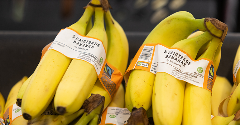News
Cocoa prices likely to increase significantly in 2024
27 Mar 2024Due to environmental factors, the International Cocoa Organization predicts an 11% drop in global cocoa output, driving cocoa prices up and raising concerns for farmers' livelihoods.
In its Quarterly Bulletin of Cocoa Statistics, the International Cocoa Organization’s (ICCO) latest figures show a projected 11% decline in the season’s main cocoa harvest for the forthcoming year.

ICCO has released its first forecasts for the 2023/24 cocoa year and revised estimates of world production, grindings, and stocks of cocoa beans for the 2022/23 cocoa year. With the current forecasts, ICCO predicts that global cocoa supply will drop by almost 11% to 4.449 million tonnes compared to the 2022/23 season and that global cocoa demand will reduce by nearly 5% to 4.779 million tonnes.
Environmental disruption affects global cocoa production
ICCO says several factors are responsible for the expected reduction in global cocoa production, including climate and weather, pests and disease, specifically swollen shoots, and orchard ageing.
Speaking to Ingredients Network, Michel Arrion, executive director of the ICCO, confirms the organisation is unaware of any quantitative analysis or assessment that discriminates between these three leading causes of lower cocoa production. “The three explanations are not new, but they might have reached some kind of turning point, and the combination of the three factors explains the loss of production,” said Arrion.
The El Niño weather phenomenon is one of the leading causes of the drop in global cocoa output. West Africa was the area worst affected by adverse weather conditions, which caused the region to experience unseasonal heavy rains followed by dry heat. “Central Africa and Latin America do not seem to be affected by a loss of production,” Arrion adds.
These adverse El Niño weather conditions impact farmers’ livelihoods. “Our main concern is the living income of the farmers,” Arrion says. “If they produce less, they sell fewer volumes, and unless the unit price is increased, their income is reduced,” Arrion adds.
Predicting price hikes
The outlook in Ghana and Cote d’Ivoire, responsible for 70% of the world’s cocoa bean production, has led to ongoing cocoa price increases in the future price markets in London and New York. Concerns about global cocoa production and expanding global cocoa deficits drive support for elevated cocoa prices.
The loss of production also creates a mismatch between global supply and demand. If supply is less than demand, international prices will increase, which is positive in principle as it allows governments to manoeuvre and increase farmgate prices.
However, this is not always the case, for example, in long-term or forward sales. “In this case, farmgate prices remain low when international prices are high,” says Arrion. “Traders benefit from high prices, not farmers,” Arrion adds.
Amid El Niño weather conditions, while global costs remain the same, unit costs are higher as global costs are divided by smaller quantities. “Global deficit means higher international prices, higher retail prices, but not necessarily higher farmgate prices,” says Arrion.
 Pictured: Illustration of climate change | © AdobeStock/Budi Sudarmanto
Pictured: Illustration of climate change | © AdobeStock/Budi Sudarmanto
Cocoa beans have been limited due to El Niño weather conditions over the past year. The lack of availability has resulted in significant increases in cocoa prices. As raw material costs increase, they are likely to have further detrimental impacts on processors’ operations. As a result of record-high cocoa prices, global demand is starting to stall.
Production loss
A significant decrease in cocoa production in Ivory Coast, the largest cocoa producer worldwide, has been reported. Cocoa shipments by Ivorian farmers to ports from 1 October 2023 to 25 February 2024 decreased by 32% compared to the same period the previous year, which could positively impact cocoa prices, insights reveal.
Le Conseil Cafe-Cacao, the Ivory Coast cocoa regulator, temporarily halted forward sales of cocoa for the 2024/25 season on 25th January. The regulator sought a more accurate estimate of the Ivory Coast’s expected cocoa production, adding to the region's supply concerns.
The Ghana Cocoa Board had to revise its 2023/24 Ghana cocoa production estimate to a 14-year low of 650,000-700,000 metric tonnes from its previous projection of 850,000 metric tonnes on 21 February 2024.
In August 2023, Ghana’s cocoa regulator announced that some cocoa farmers would unlikely fulfil their cocoa contracts for the second consecutive season. The news is concerning, as Ghana is the world’s second-largest cocoa producer.
The decline in output in Ghana and the Ivory Coast has pushed cocoa prices to historic highs, causing financial troubles for significant players and raising concerns about the sustainability of cocoa production. Furthermore, the market has risen by over 100% since last summer, when worries about heavy rains and disease issues first arose, says Weather Wealth.
Cocoa prices are likely to increase significantly in 2024 due to weather and disease issues in Ivory Coast, Ghana, and Nigeria. Ghana’s cocoa sector faces challenges such as aged trees, diseases, low farmgate prices, and climate difficulties, leading to a 35% drop in cocoa purchases.
Related news

Ultra-processed food intake in South Africa at concerning levels, study suggests
19 Mar 2024
As South Africa considers introducing front-of-pack warning labels and strict marketing limits for unhealthy foods, research has found that low-income South Africans get around half of their calories from ultra-processed foods (UPFs) – “a cause for con...
Read more
Sainsbury’s reaches living wage goal for banana workers
12 Mar 2024
UK supermarket Sainsbury’s announces it has achieved its industry commitment three years ahead of schedule and encourages other retailers to do the same.
Read more